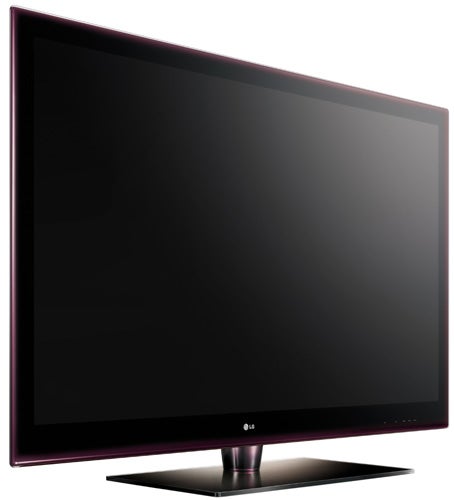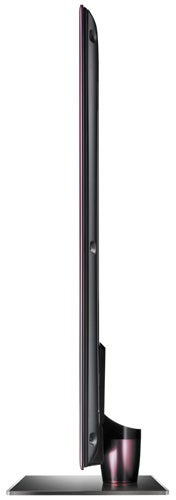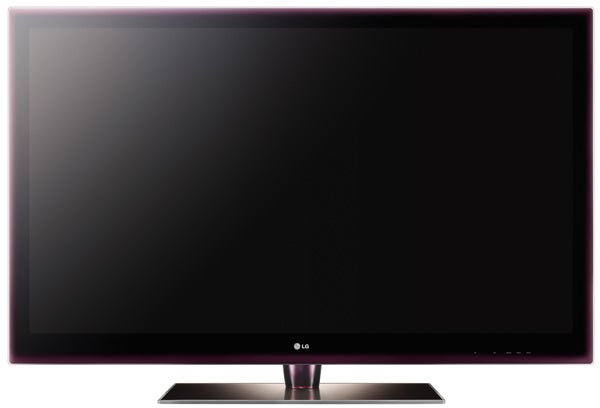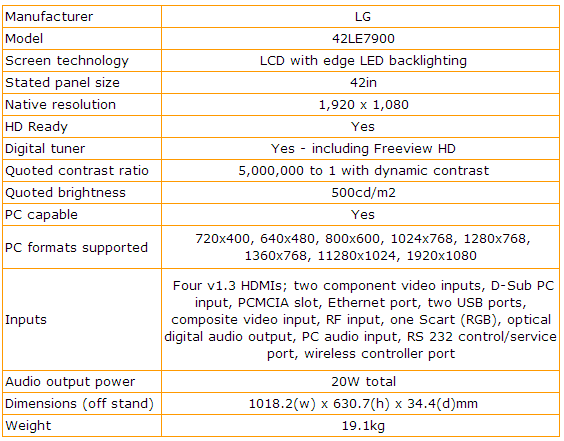LG Infinia 42LE7900 42in LED LCD TV Review
LG Infinia 42LE7900 42in LED LCD TV
Does the swanky 'Infinia' branding mark out this TV as something a bit special?

Verdict
Pros
- Very slim
- Nice multimedia tools
- Superb clarity with bright scenes
Cons
- Disappointing speakers
- Not god for dark scenes
- Poor Local Dimming feature
Key Specifications
- Review Price: £1149.95
- Four HDMI inputs
- Freeview HD and analogue tuner
- Full LED backlit LCD panel
- 1920 x 1080 full HD
- Ethernet port, 2 USB ports
I have to say that as swanky marketing names go, Infinia is pretty darned good. Not entirely original, I’ll grant you – the Viera and Bravia brand names have both proved already that you can’t go far wrong by just sticking an ‘a’ on the end of ‘pseudo words’ with lots of vowels in them. But still, Infinia raises visions and hopes of something a bit special – which in TV terms usually equates to ‘something a bit more expensive’.
And so it proves with the Infinia 42LE7900. For while the 42LE7900 can’t be considered expensive in the context of the TV world as a whole, at £1,150 for a 42in TV, it’s certainly at the upper end of LG’s usually super-aggressive pricing scale. Let’s hope, then, that it lives up to the lofty image created by the Infinia name.
Design-wise, it definitely hits the spot. It’s strikingly slim, for a start: just 34.4mm deep in its cotton socks. What’s more, its slimness is exaggerated by its totally flat fascia, where the bezel and screen appear to exist on the same single level thanks to a glass top-sheet that sits over the lot. Delicious.
It’s just a pity that LG is persisting in trying to over-market the design by suggesting that it’s Borderless when clearly it isn’t. I’ve even seen bits of marketing fluff suggesting that one reason for the Borderless name is the way the darkness of the deepest black the TV can achieve matches the blackness of the, um, border! As we’ll see presently, this excuse is sadly not borne out by reality at all. Still, however riled I might be by LG’s marketeers, it bears repeating once more that the 42LE7900 really is a very fine looking TV.
It does its best to cheer me up, too, with its connections. For as well as the four HDMI inputs I would have expected, the set’s rear and side are packed with all sorts of nice multimedia tools.
Two USBs, for instance, prove able to handle MP3, JPEG and DivX HD files, as well as allowing you to add an optional Wi-Fi dongle. That’s not the only wireless system the TV supports either, for it additionally carries built-in Bluetooth, for either streaming in pictures and music from portable Bluetooth phones, or sending audio to Bluetooth headphones. There’s an Ethernet port, too, for wired network access, as well as an RS232 for home cinema control system integration, and a PC port.
The reasons for the Ethernet port and optional Wi-Fi system are impressively numerous. For a start, they allow the TV to access files on a DLNA PC. But also they allow access to any future Freeview HD interactive services – for yes, this is another in what’s fast becoming a deluge of TVs with built-in Freeview HD tuners. Last but by no means least, the Wi-Fi/Ethernet let you access LG’s new NetCast online service.
When I say new, it’s not completely new; the service has been available in a basic form on one or two of LG’s Blu-ray players. But it’s the first time NetCast has found its way onto one of LG’s UK TVs.
To be honest, the service is currently a bit of a poor relation compared with what the likes of Panasonic, Philips and especially Sony are doing online-wise right now. All you get are weather forecasts, the Picasa online photo album site, and the inevitable YouTube. However, LG’s Widgets-powered platform should be able to grow its content over the coming months; for instance, we know that Skype video calling is going to be supported soon – provided you get an external camera and mic, of course.
As I start delving into the 42LE7900’s onscreen menus, my eye is quickly caught by a rather intriguing option: LED Dimming on/off. Now, as you might guess from its slimness, the 42LE7900 uses edge LED lighting rather than ‘direct’, or rear, LED lighting. Yet here’s an option permitting local dimming, a feature routinely cited by the direct LED supporters’ club as being one of the main advantages of that approach versus its edge-LED rival.
Delving into this little mystery deeper, the solution turns out to actually be quite simple. For LG has managed to configure its edge LED lights into 12 individually controllable ‘blocks’, with each block able to have its light output set differently to the others.
LG is the first brand to bring this intriguing technology to the UK TV market – though Sony has stated that it will do something similar with its imminent edge LED range, too.
Please note, by the way, that the 55in LE7900 has 16 blocks rather than 12, presumably because 12 doesn’t give local enough results on such a large screen. A fact which actually gives us an early hint of a rather significant problem I have with the technology. More on this in a moment.
The 42LE7900 is on rather safer ground with most of its other picture adjustments. LG has put far more picture adjustments at your disposal than the vast majority of other mainstream TV brands do – including a comprehensive colour management system, adjustable 100Hz processing, separate MPEG and standard noise reduction circuits, and a sensible gamma adjustment. 
You really could tinker with the 42LE7900’s options for hours. So it’s no surprise to find the TV officially endorsed by the Imaging Science Foundation as being flexible enough to be professionally calibrated by one of its experts. Two ISF settings are included in the picture preset menu – one for day, and one for night. And actually, you can only access some of the finer points of the 42LE7900’s picture set up facilities once you’ve entered the ISF menus.
If all this talk of professional calibration and oodles of picture fine-tuning complexity scares the living daylights out of you, then help is at hand in the form of LG’s Picture Wizard. This uses a series of reasonably well explained test signals to help you do a reasonable level of calibration yourself without having to really know what you’re doing!
As I first settled down before the 42LE7900 to see if it produces pictures as attractive as its design, I found myself immediately impressed by its extreme brightness and colour punch – even after choosing a more sensible option than the daft Vivid preset that was engaged when I got my 42LE7900 out of its box. In fact, no other edge LED TV I can think of has managed to deliver quite such a riveting, attention-commanding, dynamic performance with bright scenes as this LG. And that includes models from a certain other Korean brand.
Not that it’s all about aggression; there are plenty of subtle things going on too, resulting in, for instance, smooth, believable colour blends, and colour tones that remain believable despite their strong saturations.
There’s more subtlety, too, in the TV’s impressive talent for reproducing all the detail in an HD signal from Freeview HD or Blu-ray, right down to such minutiae as the stubble on actors’ chins and the film-like grain some Blu-ray discs like to include. It’s also great to find that the clarity doesn’t diminish much at all when images contain a lot of movement, thanks to a combination of a good innate panel response time and, presumably, the TV’s 100Hz processing engine. Furthermore, the motion processing does its work reasonably cleanly provided you keep it set to a low level.
The 42LE7900 even keeps its head comfortably above water when showing standard definition, achieving levels of sharpness and colour accuracy that are probably the best LG has managed on an LCD TV to date.
So how come the picture mark for this TV only reads an 8, not a 9 or even a 10? Because, unfortunately, the 42LE7900 falls prey to that classic LCD problem of an indifferent black level response.
At its most basic level, this problem finds parts of dark pictures that should look black instead wearing a gentle bluish tone that no amount of tinkering with the 42LE7900’s reams of settings entirely got rid of.
More aggravating, though, is the hefty extent to which black levels reduce if you watch the screen from an angle of more than just 30 to 40 degrees; the amount of reflections you get on the rather glassy screen if your room is bright; and the slight backlight inconsistencies you have to put up with.
This latter consistency problem is at its worst, sadly, when you switch the Local Dimming feature on. For while this feature is passably helpful during bright scenes, giving peak whites and bright colours a little extra sparkle, during dark scenes it can result in weird chunks of the screen looking brighter than the rest.
If you want to see this at its most obvious, darken the room a bit, and play something on the TV that features white text in the centre of a black screen, such as the legal disclaimers at the start of some Blu-rays. What you’ll see is a clear ‘square’ around the text that looks brighter than the image to either side, thanks to the edge LEDs in the area where the text is working harder than those handling the dark bits.
The example I’ve just described is, of course, extreme. But I regularly noticed some level of the phenomenon while watching a selection of films on the 42LE7900, especially if they had black bars above and below them – and it’s one of those things that once you’ve seen, you find yourself looking for again.
This will, of course, be manna from heaven to the direct LED brigade, who can use it as proof that local dimming in an edge LED situation will probably likely never rival local dimming on a direct LED TV. It will be interesting to see if Sony’s dimming edge LED TVs fare any better.
Thankfully, of course, you can actually turn off the LED dimming system if you struggle with it as much as I did. But it’s a shame to see such a promising feature not quite working as we’d hoped it might.
One final flaw we couldn’t ‘turn off’ is a very slight, slender bar of extra brightness visible during dark scenes that runs around the screen’s extreme edges. But this one’s pretty easy to live with.
The 42LE7900 sadly further dents its chances of bagging a Recommended badge from us by being a distinctly average audio performer. Its speakers just about cope with day to day telly shows, but as soon as an action film kicks into anywhere near top gear they start to sound thin, trebly and devoid of bass – to a degree that can become really tiring at even quite low volumes.
”’Verdict”’
The 42LE7900 has plenty of ‘wow’ factor in both its design and picture performance, and packs a pretty fearsome feature punch too. It’s clearly the work of a brand thinking on its feet, and hell-bent on making waves at the mid level of the TV world to go with the considerable successes it’s already achieving at the budget end.
Ultimately for me, the edge LED engine isn’t quite good enough with dark movie scenes to completely win my heart, and the set’s sound is average at best. But I’d still recommend that you at least give the 42LE7900 an audition if you can, as there really is plenty to like.

How we test televisions
We test every TV we review thoroughly over an extended period of time. We use industry standard tests to compare features properly. We’ll always tell you what we find. We never, ever, accept money to review a product.
Trusted Score
Score in detail
-
Features 9
-
Value 8
-
Image Quality 8
-
Design 9
-
Sound Quality 6
Features
| Size (Inch) | 42in |
| Display Type | LED |
| Max. Resolution | 1920 x 1080 |
| Digital Tuner | DVB-T (MPEG4) |
| Contrast Ratio | 5000000:1 |
| Refresh Rate (Hertz) | 100Hz |
Physical Specifications
| Height (Millimeter) | 692mm |
| Width (Millimeter) | 269mm |
| Depth (Millimeter) | 34.4mm, 34mm |
| Weight (Gram) | 19.1g |

